(This is the 5th part in a series on the Grow More Food campaign)
Surgim Sarju plans to rear fish and keep bees. He has been working on this project for some time now because he was “losing too much” on cash crops, he said. Already on his farm at Grass Hook, Mahaica River, he has a fish pond with hassar.
“I want to quit this cash crop and go and fish,” he said. Working steadily, he started the pond over four years ago and was about to harvest the fish, when heavy rains in July and August flooded the area and most of the hassar escaped. He lost crops too. He has been losing too much with the cash crops, Sarju says.
Like many farmers along the Mahaica, flooding is a constant problem for him. Lands along the Upper Mahaica are mostly empty now with many residents of Grass Hook and all from Joe Hook having moved from the area to escape the constant flooding. Sarju is one of the few left in Joe Hook. In July and August this year, heavy rains and high waters in the Mahaica River again, flooded farmlands along the river.
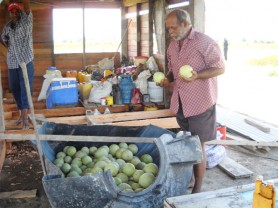
In mid-August, when Stabroek News visited the area, water had started draining off but by then Sarju said he had lost 600 roots of carilla, 600 roots of watermelon, 1000 roots of bora and saeme.
In Big Baiboo, Mahadeo sorted out small watermelons that he was forced to pick due to the flooding. But he lost 2500 roots of bora and 700 roots of watermelon, he said. At Handsome Tree, Sukdeo Dharmadat said he lost large quantities of bora and other crops. The Ministry of Agriculture has helped with raising the banks of the Mahaica River while the farmlands have been empoldered. When water rose in the river in the past weeks, the water did not get on the land as it used to but there is no drainage either, except for those who can afford pumps, so the water remains on the farmlands. Many farmers, who spoke with this newspaper, said they lost crops and the water was on the land for weeks.
“Ah the same thing abhe lifestyle in here,” said Goutan Persaud of Big Baiboo. “We plant on a scale just foh survive.”
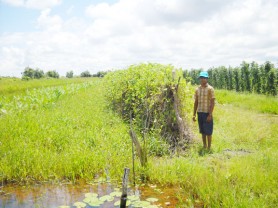
His views are echoed by other farmers who said that despite the Grow More Food campaign, they continue to plant the same acreage as before due to the problems of flooding and, now, since last year and early this year, drought. The markets fluctuate, inputs are expensive, and help from the Agriculture Ministry is limited, they said. It was pointed out that fertilizers from Suriname are cheaper to get and when the authorities clamp down on this, the prices at the local supplier rise.
Sarju said that he had responded to the campaign by growing more but first the drought came and then the flooding. He had got half a bag of fertilizer as flood relief from a previous flooding but has got no assistance through the Grow More Food campaign, he said. According to him, while farmers in the area had received assistance with flooding in the past, nothing had been done this time. Other farmers say the same thing. Many of the farmers believe that the authorities release water from the East Demerara Water Conservancy without alerting them and this contributed to the flooding. One of the problems they face during floods is rats, which eat the crops, they said.
Bright spot

A bright spot for the farmers is watermelon. Sarju said that through the New Guyana Marketing Corporation, he got in touch with an exporter, who purchased it at a reasonable price. For Deochand of Little Biaboo, the local market for watermelons is good but he continues to plant as he did before because of the uncertain weather and markets. No one has ever spoken to him about exporting, he said. His last statement is echoed by Bashkarran Tillack of little Baiboo who plants bora, tomato and pepper. He said that he has been planting the same acreage of land for years and cites the low prices for produce. At the time, he was pumping water from his crops and said that the water was on the land for a long time. Nazmoon Baksh of Handsome Tree says she has sold her watermelons to an exporter who purchased the product at the market price. She said that the New GMC helped in getting her in touch with the exporter. Flooding, however, affects her and recently she lost about 300 roots of bora and a field of watermelon with 2000 roots. Her sheep were also affected as grazing grounds were covered, she said.
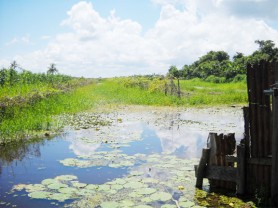
Meantime, other farmers say that middlemen buy the produce and then sell some to exporters. They said that while exporters buy once and want “A Grade” goods, the middlemen buy many times. However, some say that they sell watermelons directly to the exporters.
There is a need for more markets, farmers stressed. “The local market can’t take up the amount of produce that people plant,” Sarju said. “The amount of farm that the Minister of Agriculture tell people ah grow, it ain’t gat no market for am,” said Persaud. “Grow the food is nice but you nah get the price,” he added.
Plummeted
The low price for their produce is one of the main concerns for farmers. Over the years, prices have plummeted, Persaud says and pointed out too that since the Berbice River Bridge was opened and with crops now coming from Black Bush Polder, prices have dropped. There is “no kind of market foh tek off your goods,” he said, adding that it is more work but less money. It was pointed out that when there is flooding, prices rise.
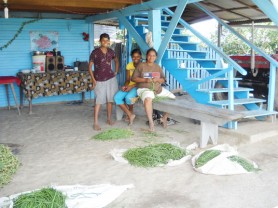
At the time, Persaud said that the markets had “a lil price.” One of the problems he had was that the area he farms in Little Baiboo was empoldered and a koker was supposed to be set up at the Little Baiboo creek but this was not done and it contributed to the flooding. Persaud, who plants plantain, bora, carila, saeme and tomato on four acres, said that he lost 300 plantain suckers, 500 root of carilla, and 2000 roots of bora. He said the one “door” placed there, malfunctioned. He could not think of increasing the acreage he cultivates due to the flooding, he said.
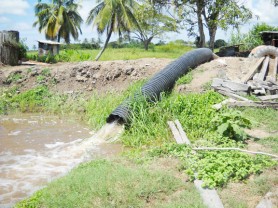
As to exporting, he said that no one was talking about this but some time back he was given some bora seeds, a variety which did not sell well here and the small “plum tomato,” which buyers did not take to. “Dah the kind of help we get from the Ministry,” he said. Some time back, the New GMC had given farmers forms to fill for them to determine what crops they were producing and said that they would contact the farmers, but nothing materialized.
“Now the salt water gone, the rain water come. That is what does kill you,” said Mahadeo sorting out some small watermelons. He said he continues to plant the same area all the time for the local market though the middleman, to whom he sell, does some exporting. “They pay us market price. It come and go,” he said. He said that he had also tried to rear some hassar but salt water leached into the pond and the fish died. “You only hear them ah sey but you see nothing about it,” he said of the Grow More Food campaign.
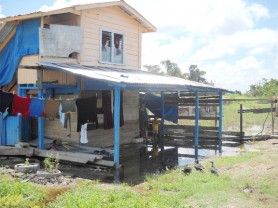
“So far me don’t understand this Grow More Food business,” says Khemraj Ganchand of Little Baiboo. He said he sells his bora to a middleman who purchases it at the market price and exports some of it. “Places like this them nah really come here and tell you about grow more food,” he said. He said that in the dry season, there are gluts in the market.
Dharmadat watches as an excavator builds up the embankment at Handsome Tree. He plants bora, watermelon, hot pepper, carilla and boulanger and said that a large amount was lost due to the flooding. He said that the Grow More Food campaign had little impact on him as he normally plants the same eight acres and sells his produce to the local market. “When you gat plenty, they nah want it. When you ain’t get, then they want,” he observed. He said that several times he has sold bora and watermelon to a middleman who said he would export the produce but this is not regular. He expressed the view that it is the exporters who make the money and not the farmer.
‘Ducked’
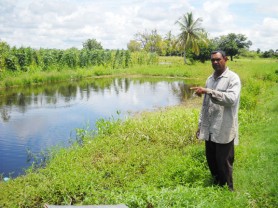
When this newspaper visited, flooding was the main issue on farmers’ minds. Sitting in her water surrounded home, Bhagrattie Lakchram of Handsome Tree said that she lost 2000 roots of watermelon, 5000 roots of bora, 300 roots of passion fruit and 300 roots of pepper in the recent flooding. She said that she normally sold only to the local market. For Yasmin Hussain, the flooding was a “disaster” and over 15 acres of rice was “ducked” and they were trying to save the rest of the crop.
But, Ramnarine Ramotar of Big Baiboo said he was not affected much. He explained that he was ill and was not doing much farming. However, he noted that he normally planted the same acreage for the local market. “Me nah grow nothing for export because me nah get market,” he said, adding that if they source an overseas market, they can definitely grow more.
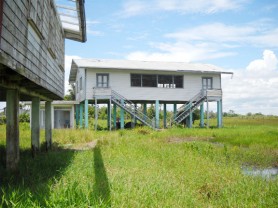
In Joe Hook, Sarju believes that there is great potential. “I does try foh me own self,” he said. He said that if he can have the use of a machine, he can dig more ponds and he knows that there is a local market for hassar. With regards to bees, he said that some Trinidadians had visited and said the area was perfect for beekeeping. Sarju had also brought back some butternut squash seeds from Canada and planted this crop three times, but earlier this year, lost the crop due to the drought and the salt water coming up the river. He had sold the previous crop at the Mon Repos market, he said.
He believes that one of the biggest problems in the country is transport. “You can’t get anything out of this country,”, he said. He also pointed out that one issue that needs to be looked at is land titling. He related that he has been waiting for three years to get a hearing at the Land Court for prescriptive title. He pointed that when attempting to get a loan, the banks ask for a land title. If he had this, he said, he would have already completed his fish ponds.




